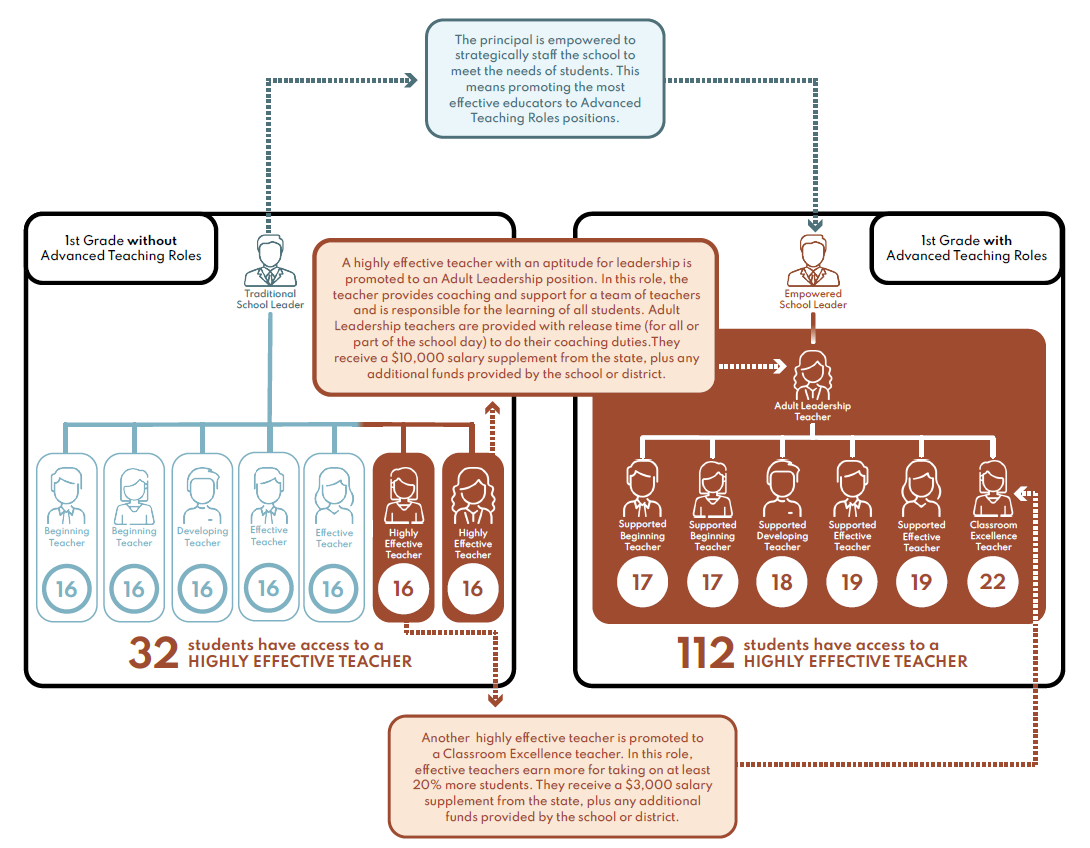Just days before the end of the school year, on a warm June morning, the North Carolina Department of Public Instruction (NCDPI) building in downtown Raleigh buzzed with energy. Principals, teachers, and school support staff greeted each other, showed their IDs, and posed for photos that would adorn their temporary security badges before heading into NCDPI’s crescent-shaped conference room.
What brought all of these school leaders to the DPI just days before summer break? The chance to learn more about North Carolina’s Advanced Teaching Roles (ATR) initiative and how to implement it within their own districts and schools.
Like many states, North Carolina has struggled for years to recruit and retain highly effective teachers. Since 2015, the percentage of new teachers who enter the classroom with little to no formalized training, has almost doubled from 22% to 41%. These teachers have been shown to have lower value-added scores over at least the first six years of their careers. Beginning teachers with less than three years of experience were also leaving the profession at much higher rates than more experienced teachers, further eroding the future workforce.
Faced with these challenges, policymakers across the state knew they had to transform how they supported both experienced and novice teachers to keep them in the classroom.
Launched in 2016 as a small pilot program, the state legislature created the ATR initiative to provide grant funding to support districts as they design and implement differentiated compensation structures and strategic staffing models for teacher leaders.
The remarkable initiative supports innovation in several ways:
- It aims to provide teachers with professional growth opportunities that link their classroom performance with salary increases for taking on additional responsibilities or students.
- It permits principals with the authority to identify highly effective teachers to lead a small team of teachers. This allows teachers to develop into multi-classroom leaders who may be fully or partially released from traditional classroom duties to provide embedded professional development to their peers, provide targeted instruction to groups of students, and increase the capacity of their team by adjusting classroom structures to most effectively meet student needs.
- It empowers principals with the flexibility to adjust class sizes to expand the reach of highly effective teachers through a waiver from the state’s class size law.
- It introduces two new state-supported roles into schools: “Adult Leadership” teachers (up to 15% of teachers per district) and “Classroom Excellence” teachers (up to 5% of teachers per district). Individual school leaders are also empowered to adjust and craft these roles to meet the unique needs of their student and teacher populations.
Adult Leadership teachers are highly effective educators who lead teams of teachers, providing job-embedded coaching as well as co-teaching and delivering small group instruction to students. These teachers are accountable for the learning outcomes of all students on their team and receive full or partial release time from traditional classroom duties. Adult Leadership teachers are eligible for a $10,000 state salary supplement in addition to any local supplement from their school or district.
Classroom Excellence teachers are other highly effective educators who earn more for taking on at least 20% more students. These teachers may also be assigned paraprofessionals, residents, or tutors in their classrooms to support instruction. They receive a $3,000 state stipend in addition to any local supplement from their school or district.
State funding for ATR transition grants has grown significantly since becoming a permanent fixture in 2020, now funded through an annual $5.5 million state budget allocation. Any district can apply for these funds to support their transition to an ATR model. The grants are primarily designed to cover technical assistance costs associated with designing and implementing a suitable ATR model. Most districts choose to start small, implementing ATR in a handful of schools and using any lessons learned to expand most effectively districtwide.
Adult Leadership and Classroom Excellence teacher salary supplements are funded through an annual $10.9 million state budget appropriation. Funding is anticipated to keep pace with the growth of the initiative statewide. Schools and districts are also encouraged to use Title I funds to offer extra compensation for ATR teachers in hard-to-staff schools in an effort to attract top talent to higher-need areas.
The Advanced Teaching Roles Initiative in Practice

Source: BEST NC
As illustrated in the infographic, after implementing ATR, a highly effective adult leadership teacher leads a team of six other educators, including another highly effective teacher who earns more for taking on additional students. This structure allows 112 students access to a highly effective teacher, instead of just 32.
State statute establishes clear requirements for educators assuming these roles, with principals given authority to require additional qualifications. These qualifications include meeting at least two of the following:
- Advanced certifications, such as National Board for Professional Teaching Standards Certification or a master’s degree in the area in which the classroom teacher is licensed and teaching.
- A rating of at least “accomplished” on each of the Teacher Evaluation Standards 1–5 on the North Carolina Teacher Evaluation instrument.
- Evidence that the teacher has an average Education Value-Added Assessment System (EVAAS) student growth index score from the three previous school years of 1.5 or greater and no individual EVAAS student growth index score below zero.
- Equivalent demonstrated mastery of teaching skills as required by the new local compensation model.
A key feature of ATR’s implementation is its long-term adoption strategy. The policy began as a pilot in several innovative districts that were eager to explore new staffing solutions. As effective strategies emerged, the policy was refined, transitioned to a permanent state initiative, and expanded to other districts. Given the significant organizational and cultural shifts required by ATR, the policy allows districts to opt in when they have the necessary leadership interest and capacity. As of 2024, roughly a quarter of districts across the state have adopted the model, with full statewide implementation anticipated within about 10 years.
The initiative’s implementation has also been supported by an external, independent champion: BEST NC (Business for Educational Success and Transformation), a business-led, nonprofit organization. BEST NC has worked to support the steady expansion of the initiative, even through multiple state leadership changes, through data collection and analysis, documentation, communications and stakeholder engagement, convenings, and direct advocacy.
While research on the impact of the initiative is still emerging, early outcomes for participating teachers include:
Improved Student Outcomes
- Statistically significant growth in student math achievement.
- Increases in the percentage of schools that met or exceeded expected student growth.
- Eighty-one percent of teachers receiving support from an ATR educator reporting improvement in academic achievement in their classes.
Greater Job Satisfaction
- Ninety-two percent of ATR educators agree the role allows them to be recognized for their expertise, and 85% agree that their role is valued by other educators.
- Educators working in schools with advanced teaching roles, but not serving in the roles themselves, also recognized the potential value of the initiative, with 76% agreeing ATR would contribute to their professional growth and 62% agreeing it would contribute to their career satisfaction.



